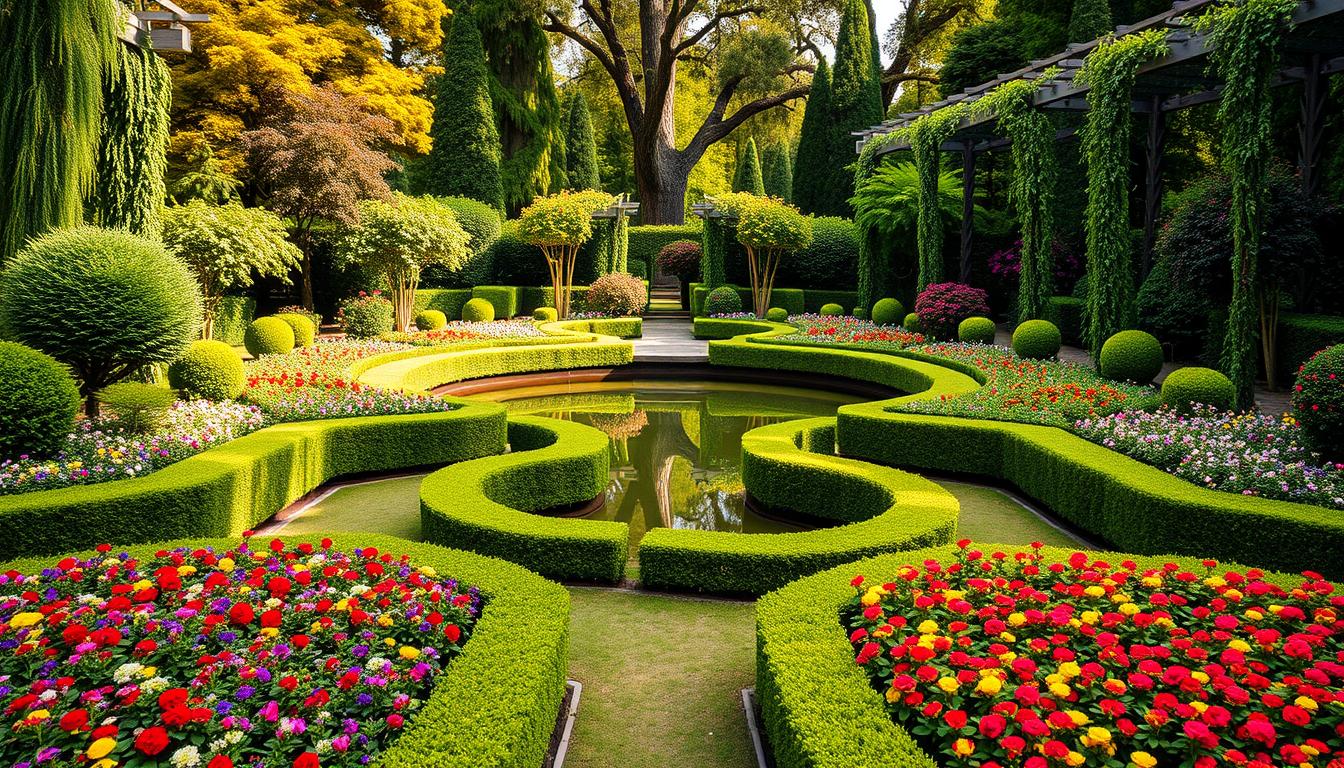Your outdoor space is more than just a yard—it’s a canvas for creativity. Thoughtful design can transform it into a cohesive and inviting area. By incorporating patterns, you can enhance curb appeal and express your personal style. Whether you’re working with a small patio or a sprawling lawn, patterns bring structure and harmony to your landscape.
In 2024, trends lean toward eco-conscious layouts and multi-functional zones. These ideas not only look great but also support sustainability. Drawing inspiration from global gardens, such as cottage styles and vertical solutions, can add unique flair to your space. No matter the size or climate of your yard, adaptable patterns ensure your design thrives.
Key Takeaways
- Patterns are foundational for cohesive outdoor design.
- They enhance curb appeal and personal expression.
- Trending themes include eco-conscious and multi-functional layouts.
- Global inspirations like cottage styles and vertical gardens are popular.
- Designs are adaptable to all yard sizes and regional climates.
Introduction to Garden Patterns Ideas
Transforming your outdoor area starts with thoughtful design choices. Garden patterns are intentional arrangements of plants, paths, and hardscapes that bring structure to your space. These layouts create a visual rhythm, making your yard feel cohesive and inviting.
Repeating elements, like shrub forms or color blocks, add harmony to your design. As Oliver Parsons, a renowned landscaper, suggests,
“Small gardens thrive with a 50% planting-to-paving ratio.”
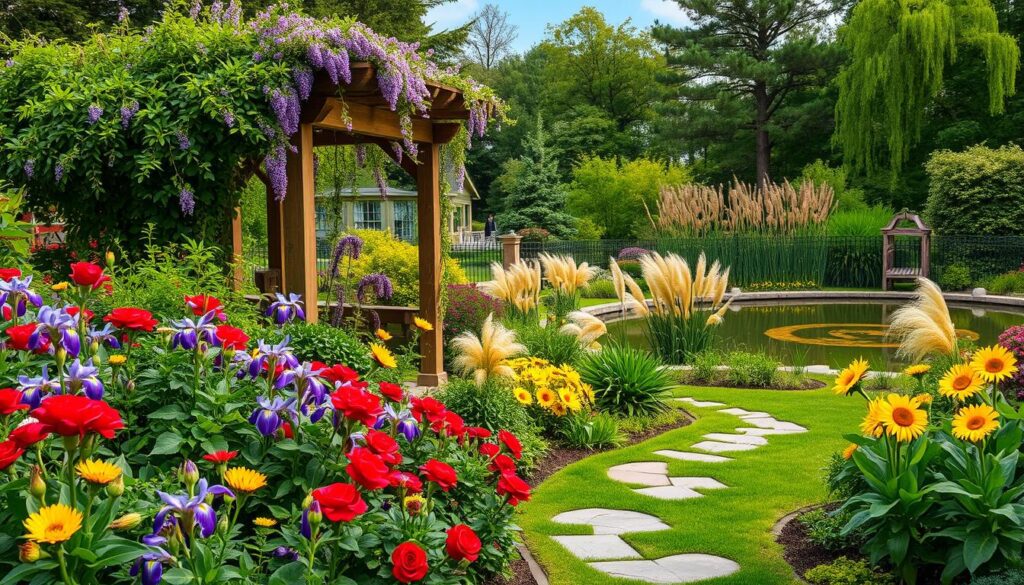
Vertical space utilization is another key principle. By incorporating climbing plants or tiered planters, you maximize your area without overcrowding. Cool color palettes, such as blues and greens, can also create a calming atmosphere.
If you’re on a budget, start with simple projects. Grouping containers or adding gravel pathways are affordable ways to introduce patterns. These small changes can make a big impact on your landscaping style.
Why Garden Patterns Matter for Your Outdoor Space
A well-designed outdoor area can elevate your home’s appeal and functionality. Patterns in your landscape design help create distinct zones, like dining or play areas, making your space more organized and practical. This approach ensures every part of your yard serves a purpose.
Seasonal interest is another key benefit. By incorporating staggered bloom times and evergreen structures, your garden stays vibrant year-round. For example, pollinator gardens not only add beauty but also increase biodiversity by 40%, according to recent studies.
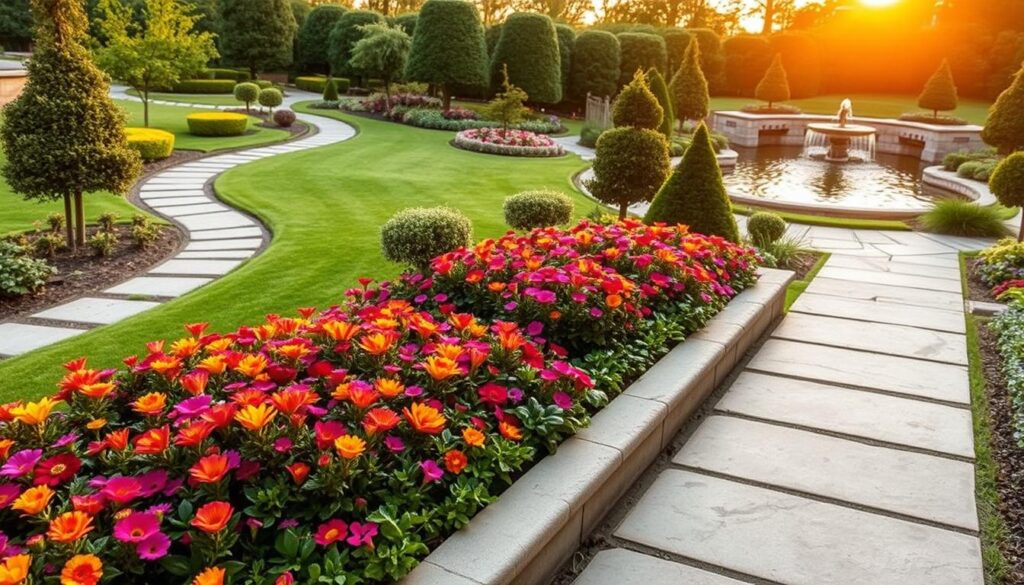
Investing in thoughtful layouts can also boost your property value. The National Association of Realtors (NAR) reports that homes with well-maintained landscapes sell 15% faster. This makes your yard a valuable feature of your home.
Beyond aesthetics and value, gardening offers therapeutic benefits. The CDC highlights that spending time in green spaces reduces stress biomarkers, promoting mental well-being. A thoughtfully designed garden can be your personal retreat.
Whether you’re looking to make garden improvements or enhance your home’s look, patterns are a smart choice. They bring structure, beauty, and purpose to your outdoor area.
Trending Garden Patterns for 2024
Stay ahead of the curve with the latest trends shaping outdoor spaces in 2024. This year’s focus is on blending sustainability with creativity, offering fresh approaches to design that cater to modern lifestyles.
Biophilic designs are leading the way. Think moss walls and native plant corridors that mimic local ecosystems. These natural elements not only enhance beauty but also support biodiversity.
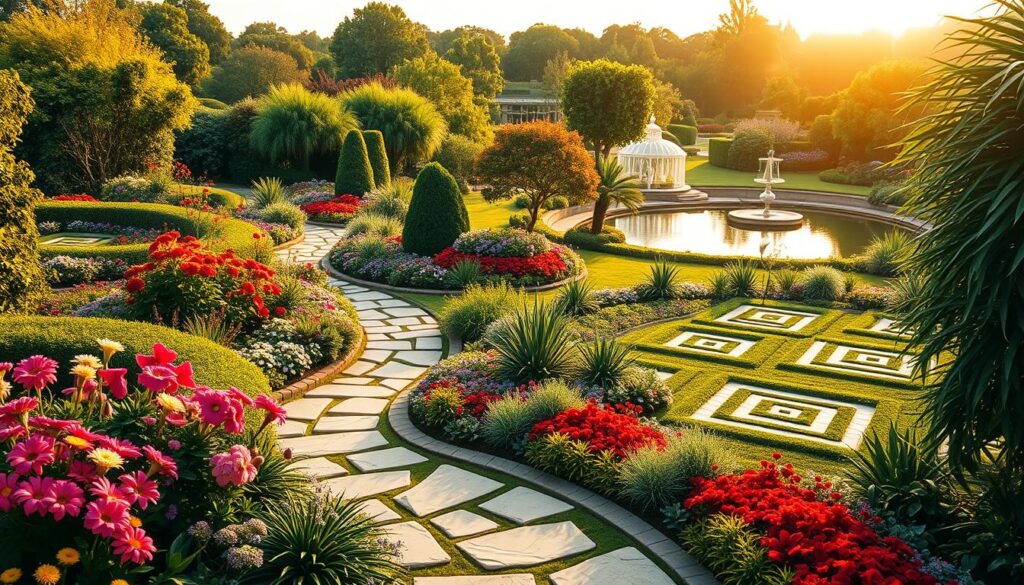
The “garden rooms” concept is another standout trend. Inspired by the Ultimate Kitchen Garden Plan, it creates distinct zones for relaxation, dining, and growing. This approach maximizes functionality while adding visual interest.
Drought-resistant xeriscaping is gaining popularity, especially in arid regions. Succulents and ornamental grasses are perfect for this low-water design. They’re practical, stylish, and eco-friendly.
Tech integration is also making waves. Solar-lit paths and smart irrigation zones are becoming staples in modern landscapes. These innovations combine convenience with sustainability.
For a bold statement, try foliage contrasts. Varieties like Heuchera ‘Forever Purple’ and Hakonechloa grass add striking color and texture to your beds. They’re perfect for creating focal points in your layout.
Whether you’re updating your shrubs or planning a complete overhaul, these trends offer something for every space. Embrace these ideas to make your outdoor area a true reflection of 2024’s style.
Designing Garden Patterns for Small Spaces
Small spaces can still make a big impact with the right design choices. Whether you’re working with a cozy patio or a narrow fence line, smart layouts can transform even the tiniest areas into functional and beautiful retreats. The key is to think vertically and creatively.

Vertical Gardening Ideas
Vertical gardening is a game-changer for tight spaces. Modular green walls are perfect for growing herbs like thyme and oregano. They add both greenery and functionality to your space.
Hanging baskets are another great option. Use them for trailing strawberries or petunias to add color and life to your patio. Repurposing ladders as tiered plant stands is a creative way to display succulents or small plants.
Container Gardening Tips
Containers are versatile and ideal for small areas. Choose dwarf fruit trees like ‘Stella’ cherry and plant them in whiskey barrel pots. They’re compact yet productive.
Maximize narrow borders with columnar evergreens, such as Sky Pencil holly. These plants add height without taking up much space. For a cohesive look, group containers in clusters of three or five.
For more inspiration, check out these boho yard decor ideas to enhance your small space.
Creating Garden Patterns for Large Yards
Large yards offer endless possibilities for creative and functional designs. With ample space, you can craft a landscape that’s both beautiful and practical. Thoughtful planning ensures every corner of your backyard serves a purpose, whether it’s for relaxation, entertainment, or nature.
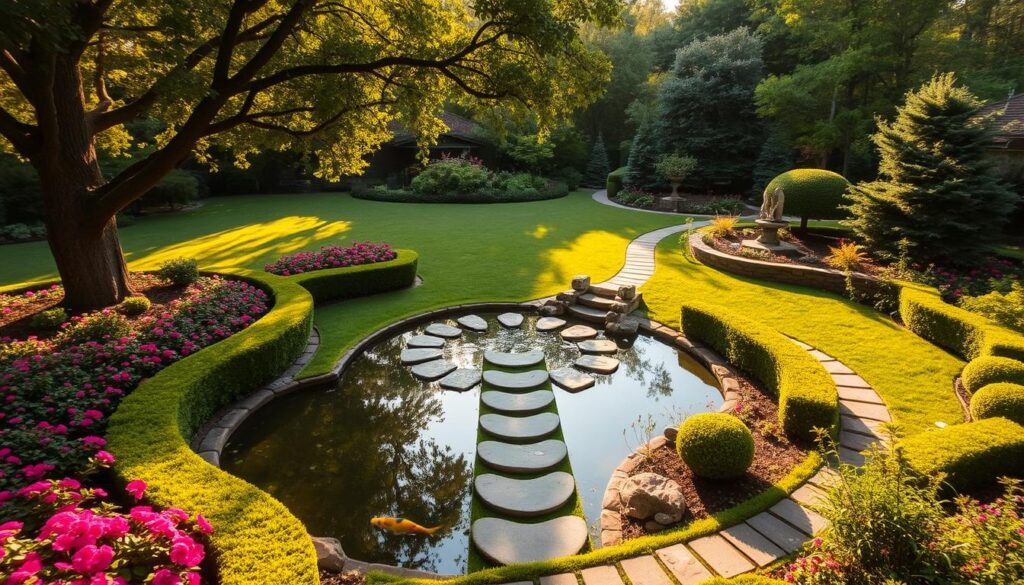
Zoning Your Garden
Effective landscaping starts with zoning. Divide your yard into distinct areas to maximize functionality. For example, create a cozy seating nook under a pergola draped with wisteria. Use mixed hedges, like boxwood and hydrangea, to define spaces without fences.
Dry creek beds are another smart choice. They add visual flow while managing drainage. Balance open lawns with specimen trees, such as Japanese maple groupings, to create focal points. This approach ensures your layout feels cohesive and inviting.
Incorporating Water Features
Water elements can elevate your backyard design. A koi pond or recirculating stream adds tranquility and movement. Using a whiskey barrel system, you can install a small stream that blends seamlessly into your spaces.
For a low-maintenance option, consider a bubbling rock fountain. These features not only enhance aesthetics but also attract wildlife. Pair them with lush plantings to create a serene retreat in your garden.
By combining zoning and water features, you can transform your yard into a stunning, functional oasis. Whether you’re hosting gatherings or enjoying quiet moments, these design ideas ensure your outdoor area shines.
Seasonal Garden Patterns: Spring to Winter
Adapting your landscape to the changing seasons keeps it vibrant year-round. By incorporating seasonal elements, you can ensure your outdoor space remains beautiful and functional no matter the time of year. From spring blooms to winter textures, thoughtful design choices make all the difference.
In spring, focus on layered planting for staggered blooms. A technique called bulb lasagna involves planting tulips over daffodils. This creates a dynamic display as the flowers bloom at different times. Pair these with early-blooming perennials like crocuses for a colorful start to the year.
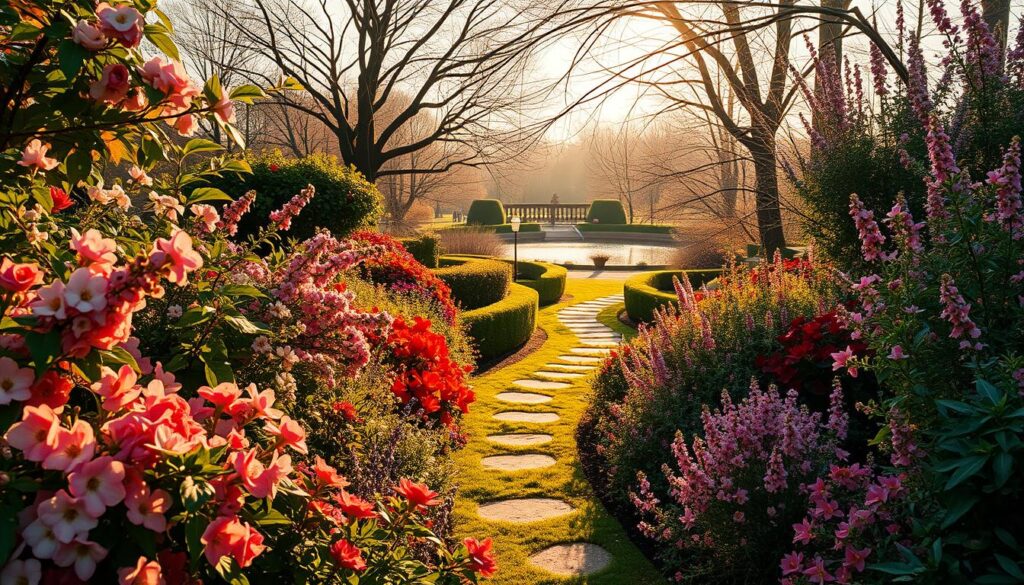
Summer is all about continuous color. Daylily drifts paired with catmint create a lively border that thrives in the heat. These combinations are low-maintenance and attract pollinators, adding life to your garden.
As fall arrives, focus on texture and warmth. Ornamental grasses paired with sedum ‘Autumn Joy’ bring a cozy feel to your beds. These plants are drought-tolerant and provide visual interest as the temperatures drop.
Winter doesn’t have to be dull. Hellebores ‘Winter Jewels’ planted under Prunus autumnalis trees add subtle color to the ground. Evergreen frameworks, like boxwood parterres and holly hedges, ensure your space remains structured and inviting.
| Season | Planting Tips |
|---|---|
| Spring | Bulb lasagna (tulips over daffodils), crocuses |
| Summer | Daylily drifts, catmint |
| Fall | Ornamental grasses, sedum ‘Autumn Joy’ |
| Winter | Hellebores ‘Winter Jewels’, boxwood parterres |
For more inspiration on seasonal decor, check out these boho backyard ideas. They’ll help you create a space that’s both stylish and adaptable to every season.
Eco-Friendly Garden Patterns
Eco-friendly designs are reshaping how we approach outdoor spaces. By incorporating sustainable practices, you can create a garden that’s both beautiful and beneficial to the environment. From pollinator-friendly layouts to rain gardens, these ideas help conserve resources while enhancing your lawn.
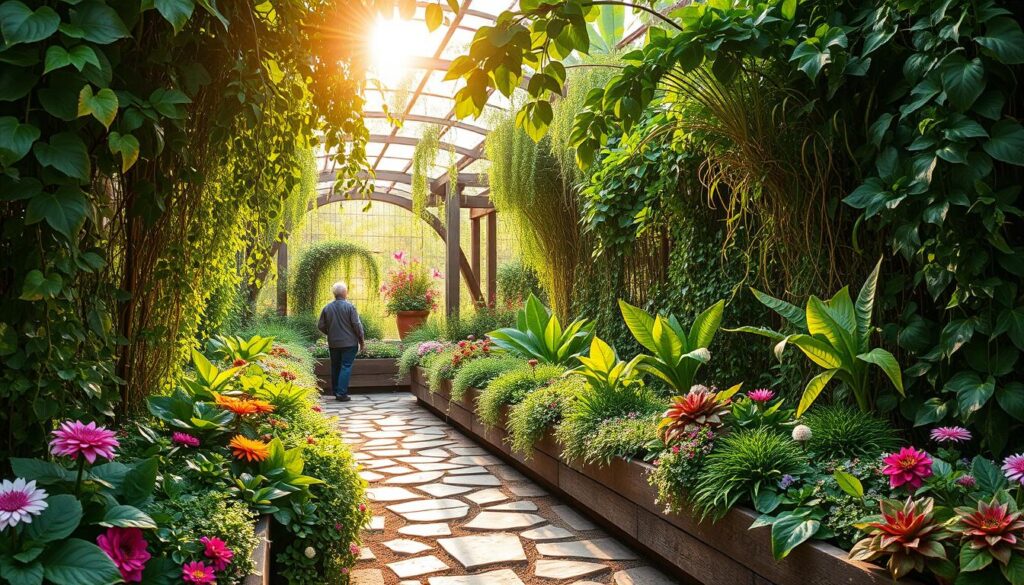
Pollinator-Friendly Gardens
Attracting pollinators is a key goal of eco-conscious design. Plant milkweed corridors to support monarch butterflies and single-flower dahlias for bees. These plants not only add color but also provide essential habitats for wildlife.
Consider using salvaged materials, like broken concrete, to create pollinator hotel bases. These structures offer shelter for beneficial insects. Integrating bat houses can also help control mosquitoes naturally, reducing the need for chemical sprays.
Rain Garden Design
Rain gardens are a smart way to manage water runoff while adding beauty to your ground. Build berms with switchgrass to filter and absorb excess water. This approach prevents erosion and keeps your vegetable garden healthy.
Replace 30% of your traditional lawn with clover or creeping thyme. These low-maintenance alternatives reduce water usage and create a lush, green space. By combining these techniques, you can create a sustainable and functional outdoor area.
Color Theory in Garden Patterns
Understanding color theory can transform your landscape into a visual masterpiece. The right combinations can evoke emotions, create focal points, and enhance the overall design of your outdoor space. Whether you’re working with vibrant flowers or subtle foliage, color plays a key role in achieving harmony.
Monochromatic schemes are perfect for a clean, elegant look. Pair white phlox with silver Artemisia ‘Powis Castle’ for a serene effect. Analogous combinations, like purple salvia, blue nepeta, and pink gaura, create a cohesive flow. These blends are soothing and visually appealing.
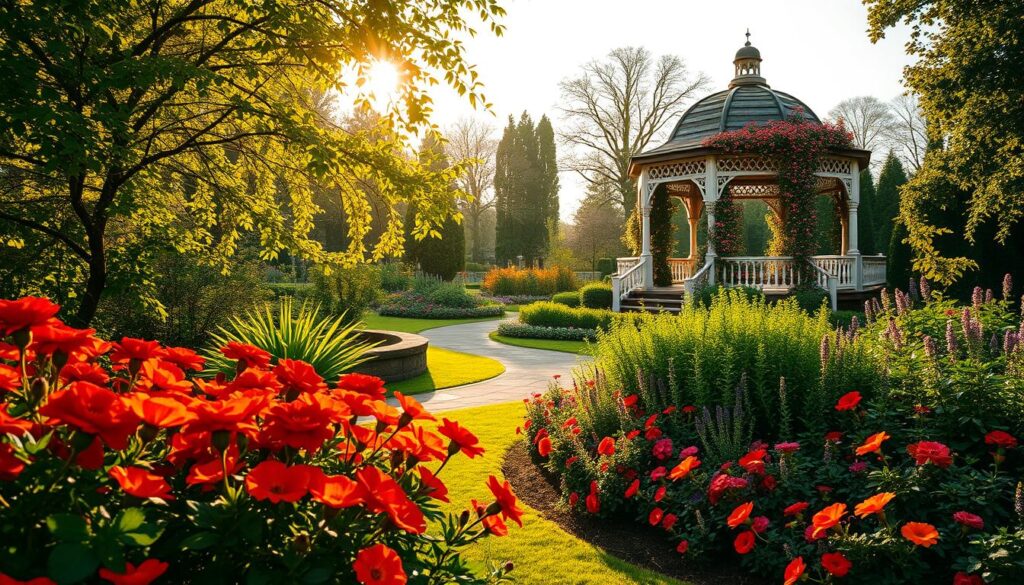
For a bold statement, try contrasting trios. Orange marigolds, purple verbena, and lime sweet potato vine create a dynamic color palette. These combinations are eye-catching and perfect for focal points in your beds.
Shade areas can also shine with the right choices. Hostas ‘Patriot’ paired with heuchera ‘Peach Flambe’ add texture and interest to darker spots. Seasonal shifts in color ensure your space remains vibrant year-round. Transition from spring pastels to summer jewel tones and fall russets for a dynamic look.
| Color Scheme | Plant Combinations |
|---|---|
| Monochromatic | White phlox + silver Artemisia ‘Powis Castle’ |
| Analogous | Purple salvia + blue nepeta + pink gaura |
| Contrasting | Orange marigolds + purple verbena + lime sweet potato vine |
| Shade Solutions | Hostas ‘Patriot’ + heuchera ‘Peach Flambe’ |
Garden Patterns for Different Styles
Your outdoor area can reflect your personality through thoughtful design choices. Whether you prefer a cozy cottage vibe or a serene Zen retreat, your space can be tailored to match your favorite aesthetic. Let’s explore two popular styles and how to bring them to life.
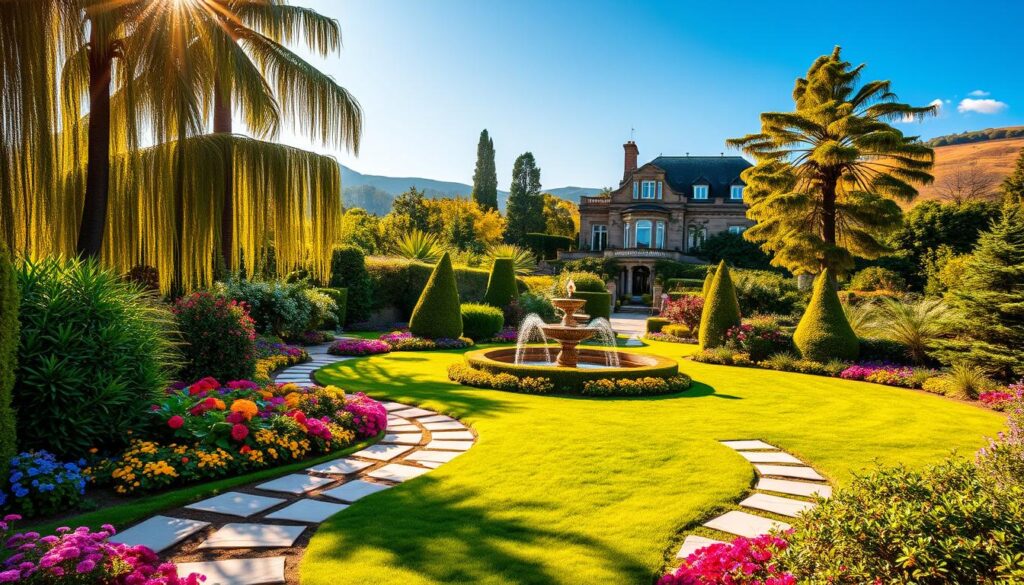
Cottage Garden Ideas
Cottage styles are all about charm and whimsy. Start with essentials like Rosa ‘Lady of Shalott’ paired with foxglove spires for a romantic feel. Mix edible and ornamental plants, such as lavender borders with espaliered apples, to create a functional yet beautiful space.
Add quirky touches like vintage teacup bird feeders for a playful vibe. These small details can make your front yard feel like a storybook setting. Soundscaping with bamboo wind chimes near water basins adds a soothing auditory element to your design.
Zen Garden Design
Zen gardens are perfect for creating a peaceful retreat. Use raked gravel circles around Acer palmatum ‘Bloodgood’ to evoke a sense of calm. These elements are simple yet impactful, making them ideal for small spaces.
Incorporate a winding path lined with moss or stepping stones to encourage mindfulness. Add a water basin or small fountain to enhance the tranquil atmosphere. This style is all about minimalism and harmony, making it a great choice for those seeking balance in their outdoor area.
Incorporating Hardscaping into Garden Patterns
Hardscaping adds structure and functionality to your outdoor space. By blending materials like flagstone walkways with woolly thyme joints, you create a seamless transition between hard and soft elements. This approach enhances both the design and usability of your patio or ground area.
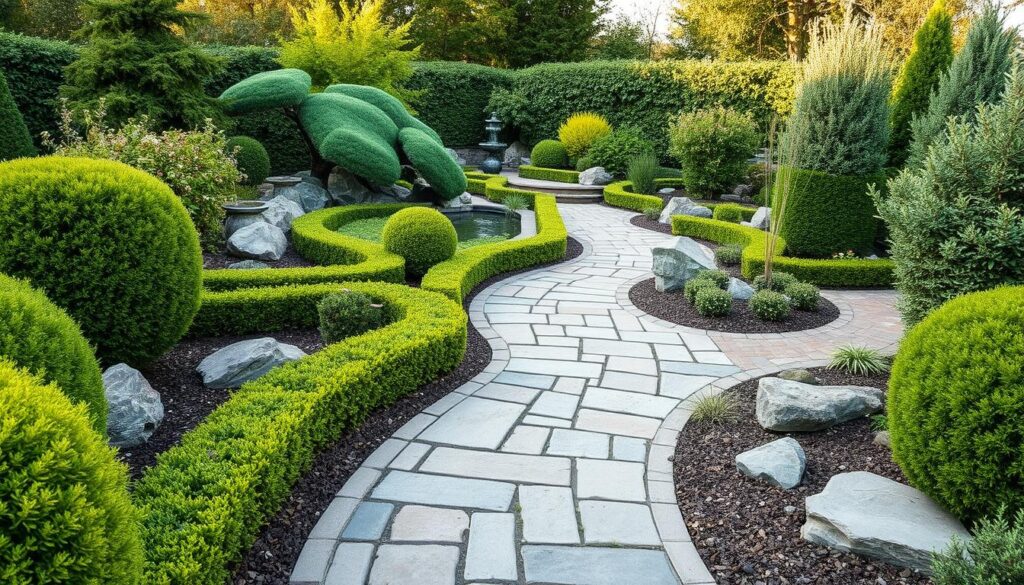
Modern contrasts can make your space stand out. For example, Corten steel edging paired with blue fescue creates a striking visual. These combinations are not only stylish but also low-maintenance, making them a practical choice for any landscaping project.
Permeable solutions like resin-bound gravel are ideal for ADA-compliant paths. They allow water to seep through, reducing runoff and keeping your bed areas healthy. As one expert notes,
“Permeable materials are a game-changer for sustainable design.”
Fire features add warmth and ambiance. Sunken gas pits surrounded by heat-tolerant sedum create a cozy gathering spot. These elements can transform your outdoor area into a year-round feature.
Retaining walls are both functional and decorative. Stacked slate with sempervivum crevices adds texture and supports sloped ground. They’re perfect for creating tiered container gardens or defining different zones in your space.
| Hardscaping Element | Design Tip |
|---|---|
| Flagstone Walkways | Use woolly thyme joints for a natural look. |
| Corten Steel Edging | Pair with blue fescue for modern contrast. |
| Resin-Bound Gravel | Ideal for ADA-compliant, permeable paths. |
| Sunken Gas Pits | Surround with heat-tolerant sedum for safety. |
| Stacked Slate Walls | Add sempervivum crevices for texture. |
Garden Patterns for Specific Areas
Designing specific areas of your property can enhance both functionality and aesthetics. Whether it’s your front yard, backyard, or side spaces, each zone offers unique opportunities for creativity. Thoughtful layouts can transform these areas into cohesive and inviting parts of your home.
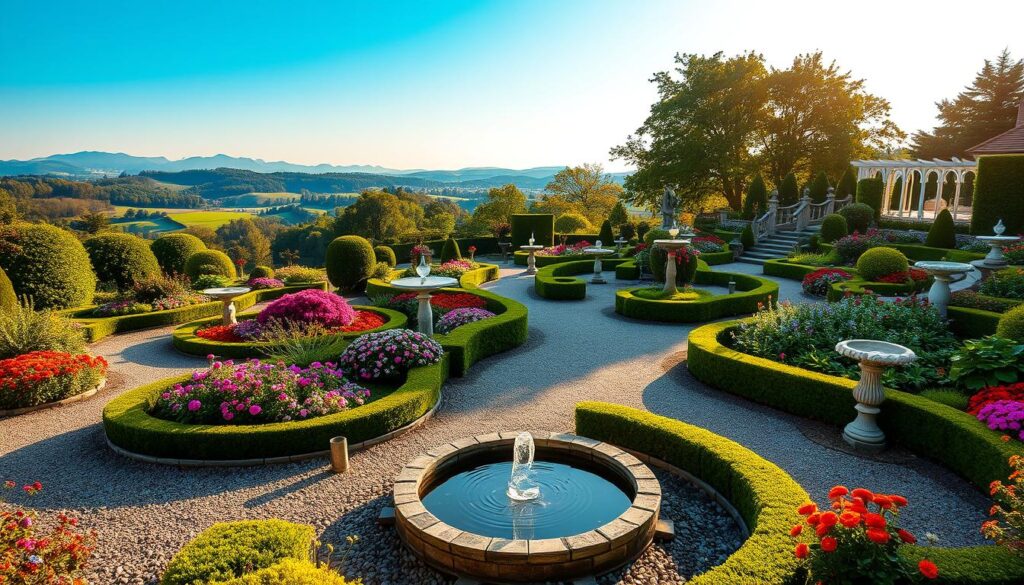
Front Yard Landscaping Ideas
Your front yard is the first impression of your home. Symmetrical boxwood globes flanking a redbud tree create a classic and elegant look. This approach adds structure and curb appeal, making your space feel welcoming.
For a modern twist, consider adding a garden bed with seasonal flowers. Pair them with low-maintenance shrubs to keep the design fresh year-round. A well-planned border can also define the space while adding visual interest.
Backyard Garden Patterns
The backyard is your personal retreat. Hidden seating nooks under grape arbors offer a cozy spot for relaxation. These areas can be enhanced with climbing plants or decorative lighting for added charm.
For larger spaces, create distinct zones for dining, play, or gardening. Use natural materials like stone or wood to define each area. This approach ensures your backyard is both functional and beautiful.
Side Yards and Driveway Borders
Side yards often go unnoticed but can be transformed into functional spaces. Narrow rain chains directing water to fern groves add both beauty and utility. These features are perfect for small, overlooked areas.
Driveway borders can also make a statement. Plant Allium ‘Globemaster’ with dwarf fountain grass for a striking border. These combinations are low-maintenance and add texture to your landscape.
Privacy Screens and Creative Solutions
Privacy is essential for any outdoor space. Clumping bamboo ‘Blue Chungii’ in trough planters creates a natural screen. These plants are fast-growing and add a touch of elegance to your backyard.
For a more creative solution, consider using trellises with climbing vines. They provide privacy while adding greenery to your landscaping. These ideas ensure your outdoor areas are both functional and stylish.
DIY Garden Patterns: Tips for Homeowners
Crafting your own outdoor space doesn’t have to be expensive or complicated. With a few creative ideas, you can design a garden that reflects your style and fits your budget. Here are some practical tips to get started.
Repurposing materials is a great way to save money. Turn old pallets into vertical strawberry towers for a functional and stylish addition to your space. This project is perfect for small areas and adds a unique touch to your gardening efforts.
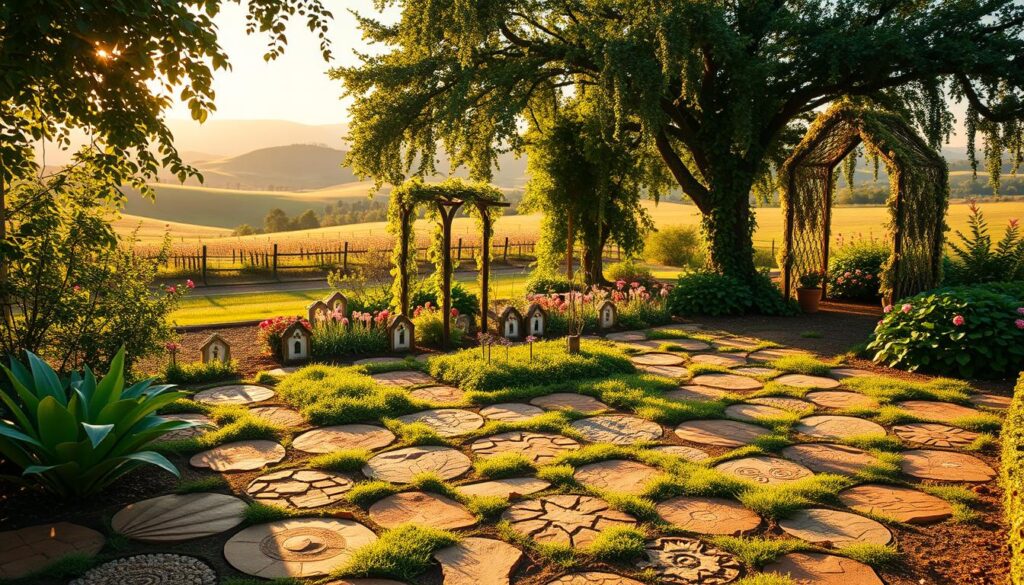
Starting small is another smart approach. A 4’x4’ square foot plant bed with quick-growing radishes is an easy way to see results fast. This method is ideal for beginners and helps you build confidence as you expand your projects.
Propagation is a budget-friendly technique. Take Coleus cuttings and place them in mason jars with water. In a few weeks, you’ll have new plants ready for your pots. This method is simple and rewarding.
Visualizing your layout is key to success. Apps like iScape allow you to experiment with designs before committing. These tools are especially helpful for homeowners who want to plan their space like a designer.
For unique varieties, join seed swaps. Look for rare finds like ‘Dragon’s Egg’ cucumber to add a special touch to your garden. These exchanges are a fun way to connect with other enthusiasts and diversify your plant collection.
| DIY Tip | Benefit |
|---|---|
| Repurpose pallets | Cost-effective and space-saving |
| Start small | Quick results for beginners |
| Propagate plants | Free new plants from cuttings |
| Use visualization apps | Plan layouts like a pro |
| Join seed swaps | Access rare plant varieties |
As one expert notes,
“DIY projects empower homeowners to create personalized spaces without breaking the bank.”
With these tips, you can transform your outdoor area into a beautiful and functional retreat. Whether you’re a seasoned gardener or just starting, these ideas make it easy to achieve stunning results.
Conclusion: Start Your Garden Transformation Today
Embarking on your outdoor transformation is easier than you think. By focusing on key principles like zoning, repetition, and focal points, you can create a cohesive and inviting space. Start small with a simple project, such as an herb spiral or a birdbath centerpiece, to build confidence and see quick results.
Share your progress on social media to connect with a community of like-minded enthusiasts. Resources like local native plant societies and USDA zone maps can guide your gardening journey. Remember, your dream garden grows one pattern at a time.
Whether you’re a beginner or a seasoned designer, there’s always a way to enhance your outdoor area. Take the first step today and watch your space transform into a beautiful and functional retreat.

